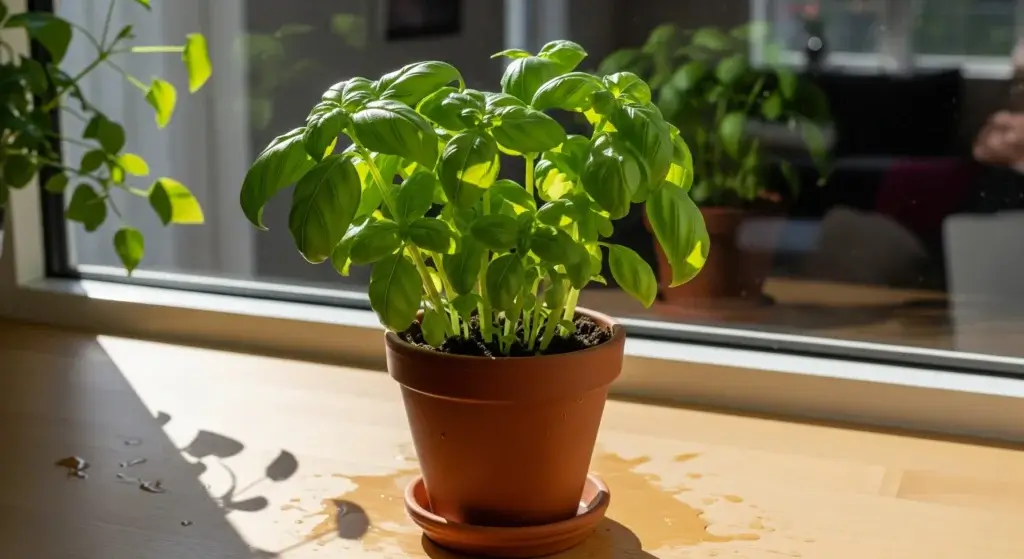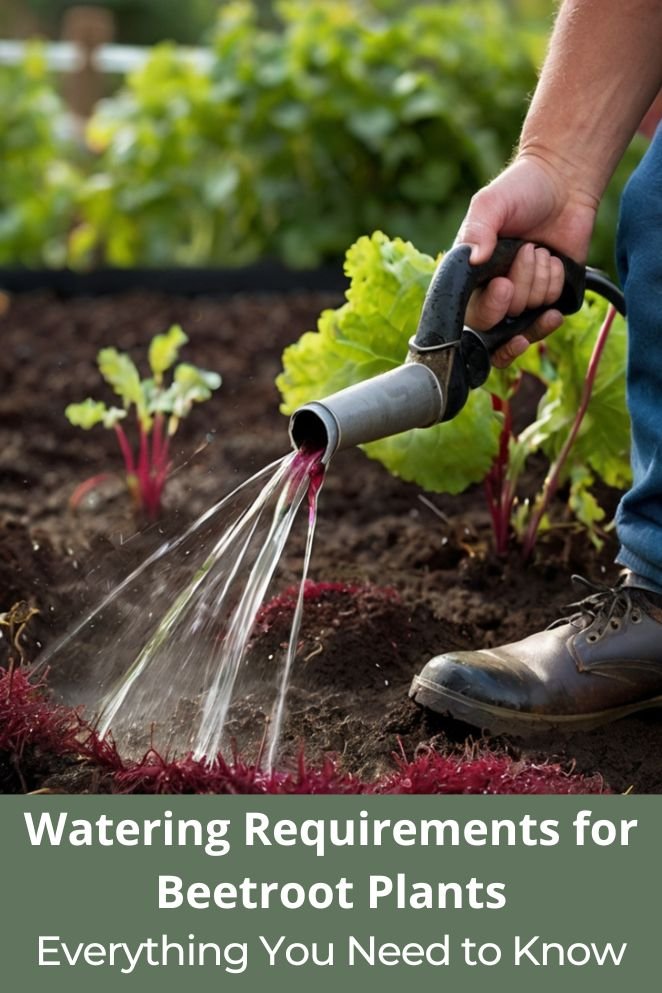
Want juicy, sweet beets? It all comes down to watering.
Beetroot might seem low-maintenance, but getting the water right is what makes the difference between tough roots and tender, tasty ones.
In this guide, we’ll break down exactly how much and how often to water your beets—whether you’re a backyard grower or trying to impress at the next farmer’s market.
Think of it like keeping your plants on a good skincare routine: timing, consistency, and not overdoing it.
From sprouting seeds to full-grown roots, we’ve got you covered—no fluff, just the watering tips you actually need.
Understanding Beetroot’s Water Requirements
How much water do beets really need?
Beets like their soil like Goldilocks likes her porridge—not too wet, not too dry.
They do best with about 1 inch (25mm) of water a week, including rain.
Think of it like keeping a steady drip going, not soaking them one day and ghosting them the next.
Big swings in moisture mess with germination, slow down growth, and can even cause the roots to crack like bad pottery.
Soil moisture testing
Wondering if it’s time to water? Dig about 3–4 inches down near the plants.
The soil should feel lightly damp, not soggy. Here’s the hack: grab a handful of soil and give it a squeeze.
- If it holds its shape but crumbles easily—perfect.
- If it turns into a wet clump like playdough, you’re overdoing it.
- If it falls apart like sand, your beets are thirsty.
Keep it balanced, like a good workout routine—consistent effort without overdoing it.
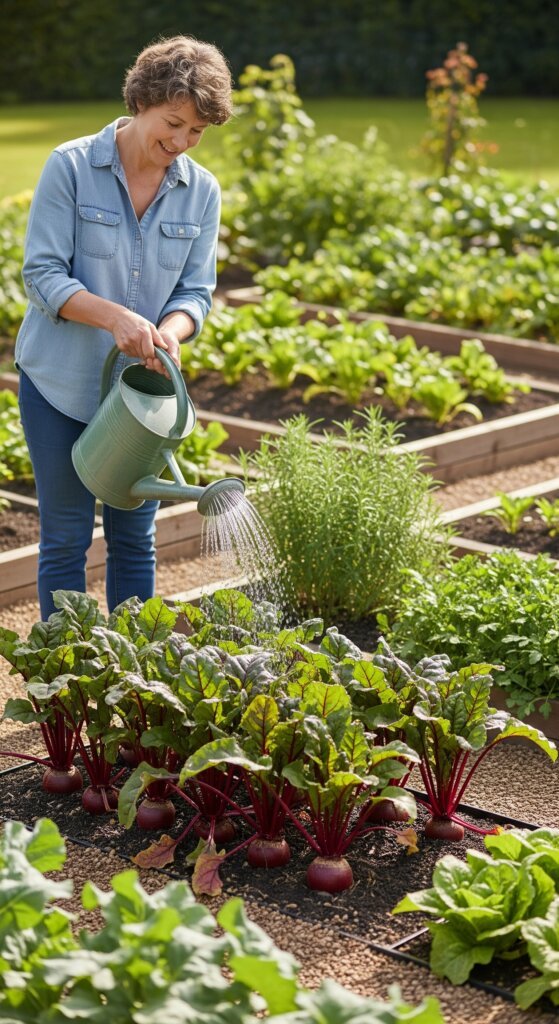
Establishing the Perfect Watering Schedule
Weekly watering guidelines
Beets don’t like being babied every day. Give them a deep soak once a week—about an inch of water in one go.
Think of it like meal-prepping: one solid session keeps them going strong.
This kind of deep watering trains the roots to grow down into the soil where it’s cooler and more stable.
Strong roots = stronger plants.
Adjust for the weather like a pro:
- Hot days: If it’s blazing hot , bump it up to twice a week. Beets like chill vibes, so if possible, throw some shade their way during peak sun hours.
- Rainy days: If Mother Nature’s doing the watering for you, back off. Check the soil first—too much water is just as bad as too little.
- Season shifts: In early spring when it’s cooler, you can water less. But in summer? Beets need more regular check-ins.
Daily quick checks
You don’t have to water daily, but a quick morning scan is smart.
If the leaves look droopy or the topsoil’s bone dry, it’s time to step in.
Catching issues early keeps things smooth—kind of like checking your phone battery before heading out.
Optimal Watering Techniques and Methods
Drip irrigation
If you’re serious about beets, drip irrigation is the way to go.
It delivers water straight to the roots, keeps the leaves dry, and helps you avoid those annoying fungal issues.
Think of it like Spotify Premium for your plants—steady, no wasted effort, no surprise ads (aka diseases).
To set it up, just lay some perforated tubing along your beet rows.
Water slowly seeps out right where the plants need it.
It’s a solid setup for bigger gardens or anyone who wants less guesswork.
Hand watering
If you’re growing in containers or have a small patch, hand watering totally works—you just gotta do it right.
Use a watering can with a gentle sprinkle or a hose with a soft spray setting.
No pressure washers here—you’re not cleaning the driveway.
Best time to water? Early morning. It gives the plants time to soak it all in before the heat kicks in.
Avoid evening watering—going to bed with wet leaves is how beets catch a cold (okay, fungus, but still).
Mulch
Want to stretch the time between waterings? Mulch is your best friend.
Throw down a 2–3 inch layer of straw, shredded leaves, or composted stuff around your plants.
It keeps the soil cool, holds moisture longer, and blocks weeds from crashing the party.
Just mulch before your regular watering to lock it all in.
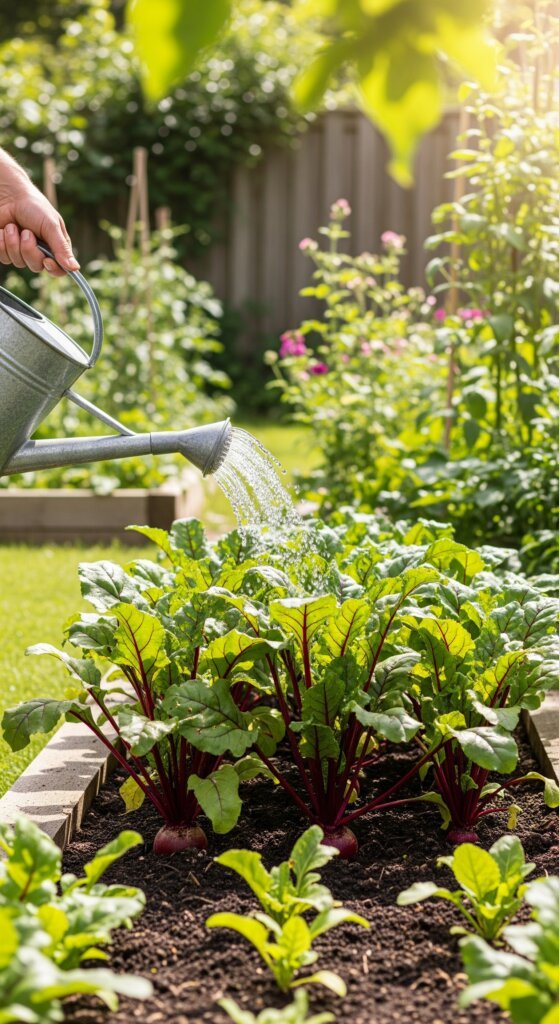
Watering During Different Growth Stages
Germination and seedling stage
Want better germination? Soak your beet seeds in room-temp water for about 24 hours before planting—it’s like pre-gaming for a stronger start.
Once they’re in the ground, keep the topsoil moist (not soggy!) until you see sprouts—usually in 7 to 14 days.
Use a gentle mist or spray, like you’re handling baby Yoda.
No hard blasts of water, or you’ll end up with runaway seeds and sad soil.
A rose attachment on your watering can works great for this.
Vegetative growth phase
Once those little guys are up and growing, switch to your regular watering schedule—usually once a week with a good soak.
This is when the leaves bulk up and roots start forming.
Beets have shallow roots, so don’t go digging around or splashing water like you’re in a garden water fight.
Water gently and keep things consistent.
Root development and maturation
This is the home stretch. At this stage, your beets are filling out underground.
Keep your watering on point—too much or too little and the roots might crack or turn tough (nobody wants stringy beets).
Stick with your weekly deep watering, but start checking soil moisture more often—especially if it’s super hot or dry out.
A little consistency now means juicy, sweet beets later.
Recognizing and Addressing Watering Problems
Signs of overwatering
Overwatering is a classic beet-growing slip-up. Drown them, and you risk root rot, bugs, and stunted growth.
Watch for these red flags:
- Leaves look off: If they’re droopy, yellowing, or have brown tips with soft, mushy texture—like overcooked noodles—you’ve gone too far.
- Gross roots & soggy soil: Pull one up—if the roots are black, mushy, and stink? That’s root rot. Also, if your soil smells sour or stays swampy, it’s time to ease up.
- Slow growth: If your beets are stuck in a growth slump, soggy soil could be to blame. Wet roots can’t breathe, and that holds everything back.
Signs of underwatering
Skipping water or letting the soil go bone-dry can stress your plants just as badly. Look out for:
- Crispy leaves: Droopy, dry, yellow or brown leaves that crunch like old chips? Classic underwatering.
- Hard soil: When the soil feels like concrete and water just runs off instead of soaking in, your beets are thirsty—and struggling.
- Tough, stunted roots: Dry conditions = small, woody beets that aren’t fun to eat.
How to fix it
Overwatering
Water less, obviously—but also improve drainage.
Add compost or organic matter to heavy soil to help it breathe.
And trim off any rotting parts to stop disease from spreading.
Underwatering
Don’t dump a bucket on them all at once. Water slowly and consistently so the soil can rehydrate.
Check moisture with your finger before watering again—because wilted leaves can show up on both ends of the spectrum.
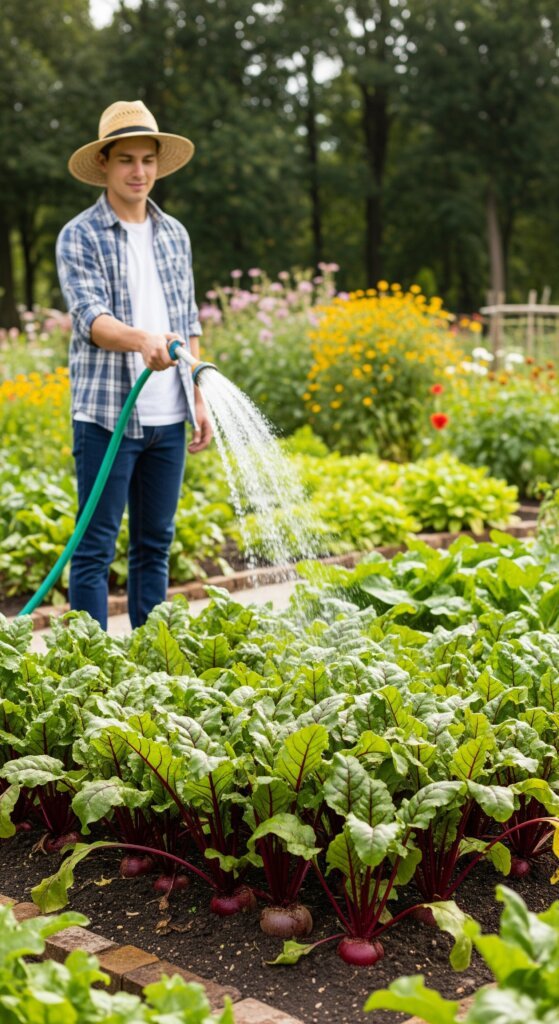
Environmental Factors Affecting Water Needs
Climate considerations
Where you live totally changes how often you need to water.
- Hot and dry? Be ready to water more often—and maybe throw your beets some shade during the heat of the day.
- Cool and humid? Ease up on watering, or you’ll end up with soggy soil and sad plants.
Soil type impact
Your soil’s like the personality of your garden—some are chill, some are extra.
- Sandy soil: Drains fast. Water disappears like it’s ghosting your plants. You’ll probably need to water more often—especially in the heat.
- Clay soil: Holds onto water forever. Go with less frequent, deeper watering or you’ll turn your garden into a swamp.
- Loamy soil: The goldilocks zone. Holds just enough moisture without drowning your beets. Stick to the usual weekly schedule.
Container growing considerations
Growing beets in pots? You’re on a tighter schedule. Pots dry out fast—especially in sunny spots.
- Check the soil every day.
- Water more often than in-ground beds.
- And make sure there are drainage holes. No one wants soggy-bottom beets.
Seasonal Watering Strategies
Spring planting
In early spring, the weather usually does half the work for you.
It’s cooler, the air’s a bit more humid, and your beets won’t be super thirsty yet.
Just keep the soil evenly moist—especially while seeds are germinating. No need to overdo it.
Summer growing
This is when beets get needy. Long days and high heat mean they dry out fast.
Water deeper and more often, especially during heat waves.
If your plants start looking stressed in the afternoon, throw up a little shade—old bedsheets, garden cloth, whatever works.
It’s survival mode, not a beauty contest.
Fall beets
Fall’s a lot more chill. Temps drop, rain usually picks up, and you can dial back on the watering.
Still, don’t coast—check the soil regularly.
Dry spells can still happen, and beets don’t like surprises this close to harvest.
Advanced Watering Tips and Techniques
Water temp matters
Cold water straight from the hose? Not ideal. It can shock your plants and slow them down.
Go with room-temp water when you can—think cozy bath, not polar plunge.
If you’re using tap water, and you’re feeling extra, let it sit overnight so the chlorine chills out.
Not a must for beets, but it doesn’t hurt.
Best time to water
Early morning (like 6–8 AM) is the sweet spot.
Less evaporation, less stress on your plants, and more time for them to soak it in before the heat kicks in.
Midday watering? Skip it.
You’ll lose half the water to the sun, and you might even scorch the leaves.
Water + fertilizer = Power combo
Timing your watering with feeding makes a big difference:
- Using liquid fertilizer? Just mix it into your usual watering session—easy win.
- Using granules? Make sure you water enough afterward so it breaks down and actually reaches the roots.
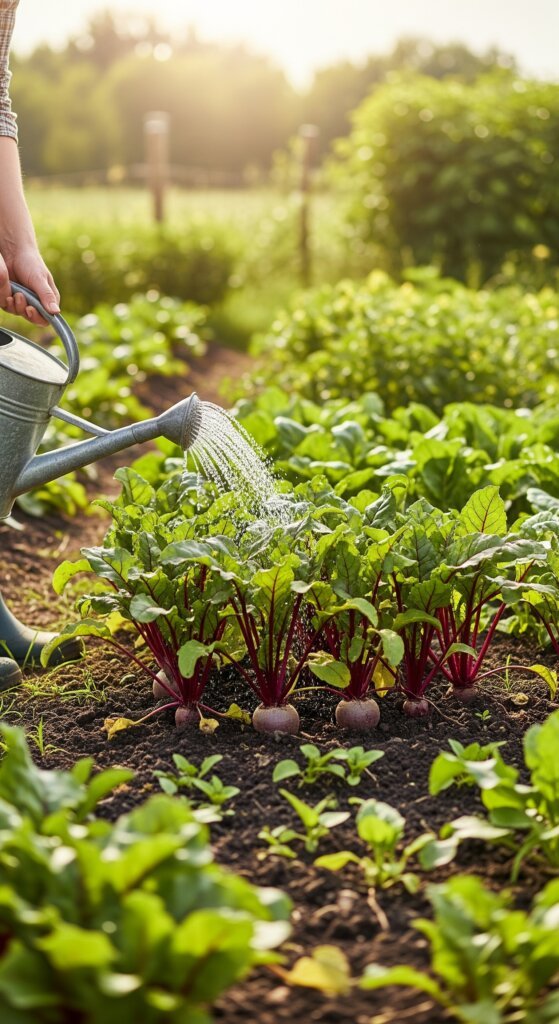
Troubleshooting Common Watering Issues
Some beets look great, others look sad?
That’s usually a sign your watering isn’t hitting every plant the same.
Check your hose or drip system—sometimes the edges get less love than the center.
Make sure water’s reaching all corners of your bed, not just the lucky few.
Seeds taking forever to sprout?
Slow or patchy germination usually means the soil dried out after planting.
For the first two weeks, your job is to keep that top layer of soil moist—not soaked, not dusty.
A light, regular misting does the trick.
Tough or split roots?
If your beets come out looking more like tree bark than dinner, that’s a classic case of stop-and-go watering.
Big dry spells followed by big soaks confuse the plant and mess with root growth.
Stay consistent—especially during those last few weeks before harvest. That’s when they bulk up and need steady moisture the most.
Final Takeaway: Keep It Consistent
Watering beets isn’t rocket science, but it does take consistency.
Aim for about an inch of water a week, keep the soil evenly moist (not swampy), and adjust based on weather, soil, and plant stage.
Use drip irrigation if you can—it’s efficient.
Hand watering works too, just be gentle. Watch for signs of over- or underwatering, and tweak as you go.
Every garden’s a little different, so keep notes on what works.
With a little trial and error, you’ll be pulling sweet, juicy beets from the ground like a total backyard boss.
Your future salads (and your future self) will thank you.



